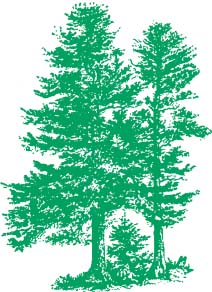CLIMATE CHANGE INFORMATION AND LINKS
|
Carbon Sequestration Facts
Forestland in the Northern Forest has an average carbon content of 106 metric tons per acre. This includes all carbon in the forest, including live biomass, dead trees and fallen trees,
Trees are roughly 50% carbon (dry weight). Increases in standing timber are directly correlated with increases in bound carbon.
Following a harvest, an estimated 32.5% of forest carbon is released to the atmosphere within five years. Another 32.5% is stored in long-lived forest products, with an average annual loss of 2% to decay or disposal and an estimated 35% of forest carbon remains stored on-site, either in unharvested material, forest soil, or coarse woody debris.
About 67% of the forest carbon is not stored in forest products following a clearcut
From a carbon standpoint wood as a construction material has a smaller carbon footprint than aluminum, steel, plastic, and concrete This is true because production of wood products is often less energy-intensive.
To grow a pound of wood, a tree uses 1.47 pounds of carbon dioxide and gives off
1.07 pounds of oxygen. An acre of trees might grow 4,000 pounds of wood in a
year, using 5,880 pounds of carbon dioxide and giving off 4,280 pounds of
oxygen in the process.
Most Americans realize that cars, trucks, and industry are a major source of CO2 emissions, but the clearing and degradation of forests is also a major factor. Deforestation accounts for approximately 25 percent of annual CO2 emissions worldwide. This is roughly equivalent to the amount of CO2 produced by the entire transportation sector (cars, trucks, airplanes) worldwide.
The U.S. carbon sink absorbs 1.1 to 2.6 million metric tons of CO2 each year, which is equivalent to 20 to 46 percent of total U.S. global warming emissions.
Estimated costs for sequestering up to 500 million tons of carbon per year - an amount that would offset up to one-third of current annual U.S. carbon emissions - range from $30 to $90 per ton. On a per-ton basis, these costs are comparable to those estimated for other climate change mitigation options such as fuel switching or energy efficiency.
The total amount of carbon in the atmosphere is about 750 billion metric tons.
Human activities - particularly the extraction and burning of fossil fuels and the depletion of forests - are primary sources of carbon emissions, totaling about 6.6 billion metric tons per year.
The oceans absorb about 2 billion metric tons and the terrestrial ecosystems about 1.2 billion metric tons more than they release.
The atmosphere is annually absorbing approximately 3.4 billion metric tons of carbon more than it is releasing.
If the current rate of carbon accumulation were to remain constant, there would be a net gain in atmospheric carbon of 25 percent over the next fifty years.
The rate of carbon absorption by terrestrial systems in the United States has been falling since 1960 and decreased by approximately 20 percent from 1990 to 2001. This decline in carbon absorption is due primarily to unsustainable forest practices and land use changes.
Maine Forests uptake about 5.3 million metric tons of carbon each year (.3 metric tons per acre) and currently store about 2000 million metric tons of carbon.
A fifty-year-old forest on average absorbs .8 metric tons of carbon per acre per year. A 65 year old forest 1.6 metric tons per acre per year.
Doubling the age of the forest in the North Maine Woods could increase carbon storage by more than 1000 million metric tons. Currently, due to management practices, the age of the forest is declining.
Between 1982 and 2003 land changes resulted in the loss of 806,957 acres of forest. This represents a total loss to the carbon sink of about 242,000 metric tons per year and the removal of about 42 million metric tons of carbon.
Maple/Beech/Birch stands have the highest carbon density per acre, storing about 550 million metric tons. Tree plantations have the lowest carbon density per acre.
Doubling the stocking on the 550,000 acres of poorly stocked stands could increase carbon storage by as much as 500 million metric tons.
Maine emits about 5.1 million metric tons of carbon per year. This is about 4.1 metric tons per capita - 14th amongst all states.
|
